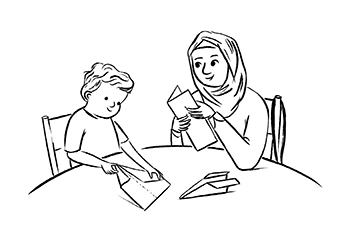Paper plane play: why it’s good for children with disability, autism or other additional needs
Paper plane play involves folding a sheet of paper into the shape of a plane and then seeing how far, fast and accurately the plane can fly.
Making paper planes can help children with disability, autism or other additional needs develop fine motor skills and problem-solving skills. It can also be a creative and imaginative activity.
Paper plane play can be good for children at stressful times. This is because paper plane play can help children to focus on something other than what’s worrying or upsetting them. Making paper planes with others can also be a great way for children to connect with others, which can be comforting and reassuring.

What you need for paper planes
- One or more pieces of paper
- A safe space to fly the paper plane
How to make paper planes
You and your child can make paper planes together. Your child could also do this activity by themselves or with other children.
Here’s how to get started with your child:
- Make a paper plane. You could search for a paper plane template online.
- Find a safe space to test fly the plane.
- Fly the plane from different starting places – for example, the top of a chair, a doorway or outside. Or your child could try to land it somewhere specific, like the sofa.
- Experiment with different wing shapes and sizes.
- Talk with your child about how things like the starting place, wind conditions and wing shape change the way the plane flies.
- Encourage your child to share their ideas about improving their plane. If your child is doing this activity with others, perhaps they could have a competition to see whose plane flies the furthest or highest.
The tip of a paper plane can be dangerous. Make sure your child aims their plane away from people’s faces.
How to adapt paper planes to suit children with diverse abilities
Children with difficulty with fine motor skills might need you to help them fold their plane. Or they might like to tell you how to do it.
For children who find social interaction difficult, try getting them to beat their own flying record. Or you might be able to organise a group activity or flying competition with just 1-2 others.
Children with sensory sensitivities might prefer it when there are fewer planes in the air. Try taking it in turns to fly your planes.
For children with a lot of energy, try asking them to run after their planes.
Looking for more play and learning ideas for your child? You might like to explore our other activity guides. Some of these have been created for typically developing children, but they can all be adapted to suit children with diverse strengths and abilities.